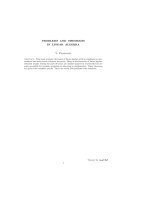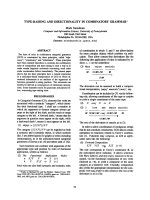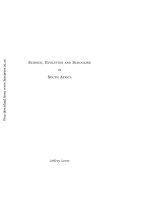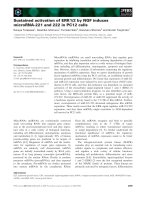IVIG, PACEMAKER AND ECMO IN ACUTE MYOCARDITIS-official.pdf
Bạn đang xem bản rút gọn của tài liệu. Xem và tải ngay bản đầy đủ của tài liệu tại đây (4.71 MB, 21 trang )
IVIG, PACEMAKER AND ECMO
IN ACUTE MYOCARDITIS
Dr. Nguyen Khiet Tam
Department of Cardiology
Children Hospital 2- HCMC
INTRODUCTION
• Definition: Myocarditis is defined by an inflammation of the
myocardium diagnosed by established histological, immunological,
and immunohistochemical criteria
• Etiology: infections (virus, bacteria, fungi, parasitic and protozoa),
drugs, toxic substances, and autoimmune diseases
Pediatric myocarditis: presenting clinical characteristics
Yamini Durani, MD, Matthew Egan, MD, Jeanne Baffa, MD, Steven M. Selbst, MD, Alan L. Nager, MD
/>
Methods
A retrospective cross-sectional study was conducted to identify patients with myocarditis and DCM who presented over a 10year span at 2 tertiary care pediatric hospitals. Patients were identified based on the International Classification of Diseases,
Ninth Revision, diagnostic codes.
Results
Common primary complaints were shortness of breath, vomiting, poor feeding, upper respiratory infection (URI), and fever.
Common examination findings were tachypnea, hepatomegaly, respiratory distress, fever, and abnormal lung examination
result. Sixty-three percent had cardiomegaly on chest x-ray, and all had an abnormal electrocardiogram results.
Conclusions
These data suggest children with acute myocarditis and DCM most commonly present with difficulty breathing. Myocarditis
and DCM may mimic other respiratory or viral illnesses, but hepatomegaly or the finding of cardiomegaly and an abnormal
electrocardiogram result may help distinguish these diagnoses from other more common pediatric illnesses.
Some recommendations on diagnosis
1. Standard 12-lead ECG should be performed in all patient with
clinically suspected myocarditis
2. All patient with clinically suspected myocarditis should undergo a
standard trans-thoracic echo at presentation
3. Trans-thoracic echo should be repeated during hospitalization if
there is any worsening of hemodynamics.
4. Troponin, VS, CRP should be assessed in all patient
TREATMENT
1. Hemodynamically unstable patients: cardiogenic shock, severe
ventricular dysfunction ECMO?
2. Hemodynamically stable patients: heart failure
3. Arrhythmia: not different from others’ causes
4. Avoidance of exercise: physical activity should be restricted during
the acute phase and for at least 6 months
IVIG IN MYOCARDITIS
IVIG IN MYOCARDITIS
• Insufficient data
• Because of the risk of death and significant morbidity associated with
myocarditis, we administer high dose IVIG (2 g/kg over 24 hours) for
children with acute myocarditis, which is confirmed by
endomyocardial biopsy, or when clinical suspicion is high
Treatment and prognosis of myocarditis in children- Uptodate 2016
PACEMAKER IN MYOCARDITIS
ECMO IN MYOCARDITIS
Indication and timing of extracorporeal life support
The following criteria were indications for ECLS therapy
(i) cardiac and pulmonary failure refractory to medical therapy,
(ii) uncontrolled arrhythmia including ventricular tachycardia or ventricular
fibrillation,
(iii) cardiac arrest, and
(iv) low left ventricular ejection fraction (LVEF) <20%.
All ECLS procedures were started within 2–4 h if the patients arrived via
emergency room. If the patients were already admitted to another
department, and an order for ECLS therapy was delivered to our team, the
ECLS procedure was performed immediately.
Extracorporeal life support can be a first-line treatment in children with acute fulminant myocarditis
Se Yong Junga, Hong Ju Shinb,c,*, Jo Won Junga, Han Ki Parkb, Yu Rim Shinb, Young Hwan Parkb, Nam Kyun Kima
and Jae Young Choia
INDICATION OF ECMO IN MYOCARDITIS
• Sốc tim thất bại với điều trị nội khoa:
•
•
•
•
•
đã dùng liều adrenalin > 0,2 mcg/kg/phút hoặc
dobutamin > 20 mcg/kg/phút noradrenalin 0,2 mcg/kh/phút
và tối ưu tiền tải;
siêu âm tim CI < 2,2 L/phút/m2; hoặc EF < 20 %,
lactate máu > 5 mmol/L
(ICU BV Chợ Rẫy)
THANK YOU FOR YOUR LISTENING









